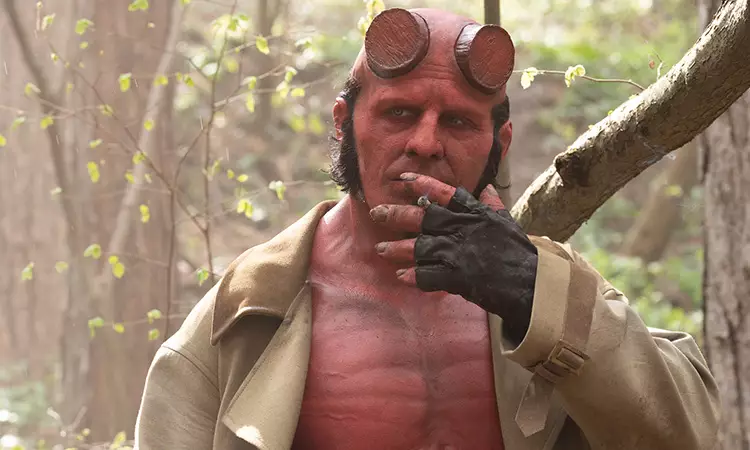The world of comic adaptations often faces the daunting task of balancing fidelity to source material while appealing to a broader audience. “Hellboy: The Crooked Man” marks a significant return for the beloved character created by Mike Mignola, embracing darker themes and a more authentic feel that resonates strongly with comic book fans. With Brian Taylor, known for his work on “Crank,” at the helm and a narrative connecting directly with Mignola’s original vision, this film attempts to reclaim the franchise’s footing amidst a backdrop of mixed reviews from previous adaptations.
Twenty years have passed since Ron Perlman first donned the red makeup and horns in Guillermo del Toro’s “Hellboy.” The franchise has experienced a tumultuous journey since then, encountering the highs of a successful sequel and the lows of a lukewarm reboot featuring David Harbour. Amidst this uneven track record, “Hellboy: The Crooked Man” aspires to reinvigorate the character’s essence by steering the story into darker, more frightening territory. This iteration privileges atmosphere over exposition, guiding audiences through a narrative that feels both fresh and nostalgically steeped in the original comic lore.
Set against the eerie backdrop of 1959 Appalachian forests, the film centers around Hellboy and his novice partner, Bobbie. Their mission soon devolves into a struggle for survival and clarity as they stumble upon a cabal of witches and their insidious leader, the Crooked Man. This premise allows the film to delve deep into supernatural folklore while maintaining an air of suspense that is characteristic of horror genres. The narrative unfolds with a confidence that suggests a thorough understanding of its source material, cleverly intertwining character development with procedural storytelling.
“Hellboy: The Crooked Man” firmly positions itself within the horror genre, elevating the horror elements through meticulous direction and a compelling atmosphere. Jump scares are artfully employed, coupled with unsettling visuals that linger in the mind long after viewing. Drawing from Taylor’s experience with the show “Happy,” there is an underlying tone that blends humor and horror—a space where the grotesque becomes familiar and the bizarre feels normal. Such strategic directorial choices work harmoniously with Mignola’s original vision, creating an immersive experience that balances tension and intrigue.
At the center of this tumultuous world, Hellboy emerges as the grounding force. He is not merely a passive observer but an active participant, navigating the chaos that envelops him. His stoicism juxtaposed with the erratic happenings around him serves to heighten both the narrative’s tension and the audience’s engagement. The film does not overly explain Hellboy’s motivations or the happenings around him, which not only respects its source material but also invites viewers into a more organic understanding of the story.
In terms of casting, Jack Kesy steps into the role of Hellboy, giving a fresh take on the character while acknowledging the legacy of Perlman and Harbour. While Kesy’s performances may lack the flamboyance that previous portrayals exuded, he embodies a more restrained yet poignant version of the iconic demon. The subtleties of his delivery offer a new depth, showcasing Hellboy’s struggles in a tangible way that makes him a relatable anti-hero despite his unorthodox nature.
Supporting characters, such as Bobbie and local resident Tom Ferrell, enrich the narrative, each bringing unique elements to the story. Their interactions with Hellboy deepen the thematic exploration of isolation, community, and the concepts of good versus evil. As they collectively uncover the mysteries of their haunted surroundings, the film explores their relationships, further heightening the stakes of the overarching conflict.
However, it is also worth noting that “Hellboy: The Crooked Man” occasionally feels like it is contending with its budget constraints. The production may lack the polished extravagance typically associated with larger franchises, which can detract from its grander ambitions. At certain moments, the aesthetic teeters on the edge of feeling like a fan project rather than a full-fledged cinematic experience. Yet, this grittiness inadvertently adds a certain charm, resonating well with fans who appreciate the raw essence of the original comics.
Ultimately, “Hellboy: The Crooked Man” encapsulates a bold experimental approach that boldly blends horror and dark humor. It combines Mignola’s lush storytelling with a striking directorial vision, revitalizing a franchise that has seen its fair share of highs and lows. By doing so, it not only pays homage to the rich lore of the Hellboy universe but also carves out a compelling narrative space for future explorations. For fans of the original comics and newcomers alike, this film offers a unique glimpse into the enigmatic world of Hellboy, promising thrills and chills for all.

